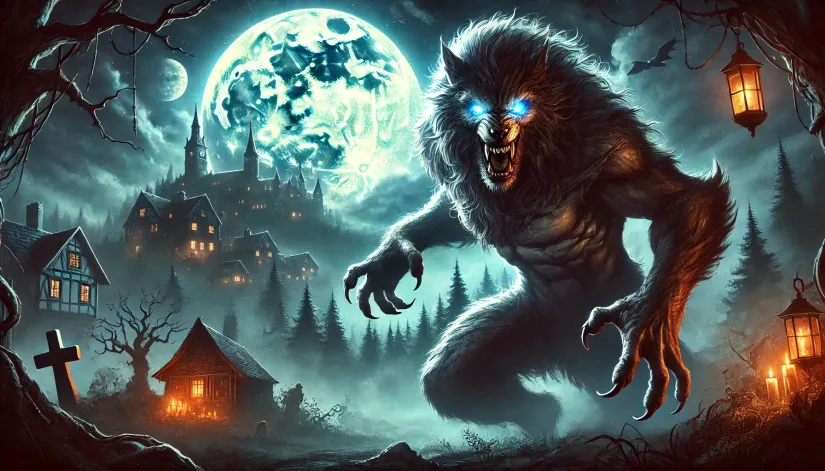If you’re into the paranormal, you’ve definitely heard about werewolves—also referred to as lycanthropes or wolf-men. It’s a legendary creature that can shift into a wolf or wolf-like hybrid animal. Or that’s how the story usually goes.
The transformation can happen on purpose or as a result of a curse or affliction (like being bitten or scratched by another werewolf). And it’s typically linked to the full moon.
But what most people don’t realize is that the werewolf myth is way more complex than what you see in Hollywood movies or horror novels. And it’s old… ancient even.
In this article:
Where Did the Word “Werewolf” Come From?
The etymology of the word “werewolf” is rather fascinating. The word comes from the Old English term “werewulf,” which connects to similar words in Middle Dutch, Middle Low German, Middle High German, and West Frisian.
All these terms trace back to the Proto-Germanic “wira-wulfaz,” meaning “man-wolf.” Similar words in other languages (like Old Norse’s “úlfheðnar” and “úlfheðinn,” Old Irish’s “luchthonn,” and Sanskrit’s “Vṛkājina,” for example) are also related to these terms.
In the Norse language, “vargúlfr” replaced “wiraz” with “vargr”—which means “wolf” or “outlaw.”
This might have been influenced by the Old French expression “leus warous” or “lous garous” (modern “loup-garou”), meaning “wolf-werewolf.”
However, the modern Norse forms of the word (“varulv” and “varulf”) were likely either borrowed from Middle Low German or derived from an unattested Old Norse “varulfr.”
The Proto-Slavic noun *vьlko-dlakь (meaning “wolf-haired”) appears in Serbian, Slovenian, and Czech languages.
However, the many variations in Slavic languages, plus the later changes to some of these forms, make tracing the exact origin almost impossible.
In Balkan folklore, Greeks and Romanians borrowed the term to refer to vampire-like creatures. At the same time, Albanians and Turks used variations of the same word.
Bulgarians and Church Slavonics may have borrowed the term from Greek.
The name “vurdalak” first appeared in Russian poet Aleksey K. Tolstoy’s “The Family of the Vourdalak” in 1839. The same term is also briefly mentioned in Pushkin’s novel “Pesni o veshchem Olege” (“The Song of the Wise Oleg”).
A Proto-Celtic noun, *wiro-kū (meaning “man-dog”), is a reconstruction of Celtiberian, Old Brittonic, Old Irish, and medieval personal names. How so? In Celtic cultures, wolves were often metaphorically called “dogs.”
Head-scratching concepts? That’s what etymology is all about. And more so for such an archaic concept.
But we find it quite fascinating. It’s an ancient term with a fascinating history that shows just how widespread the werewolf myth was (especially across Europe). And how many nations needed their own words to describe this mythical creature.
Now, “lycanthropy” is a lot easier to explain.
The term “lycanthropy” comes from the Ancient Greek “lukanthrōpía”—meaning “wolf-man.” Initially, it referred to a clinical condition in which a person believed they were a wolf.
Nowadays, many people use “lycanthrope” as a synonym for “werewolf,” but there are some subtle differences between these two concepts.
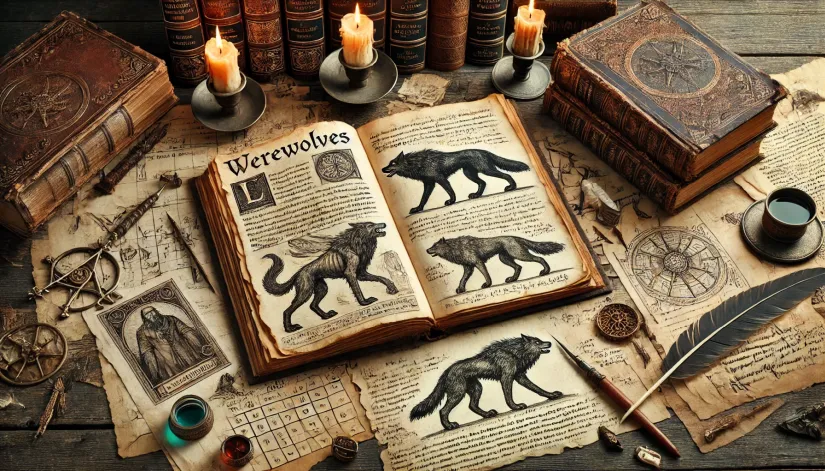
What is the Difference Between a Lycanthrope and a Werewolf?
In modern contexts, “werewolf” typically refers to a person who transforms into a wolf, often involuntarily and associated with the full moon. This term is commonly used in folklore, literature, and popular culture.
On the other hand, “lycanthrope” is a broader term used in more clinical or mythological contexts. It refers to any human who believes they can transform into a wolf or another animal (not just limited to folklore and moon cycles).
Culturally and in literature, lycanthropes are sometimes depicted as having more control over their transformations than traditional werewolves.
For example, lycanthropes might be able to shift at will and retain more of their human consciousness and control in their wolf form.
On the other hand, werewolves—especially in older folklore—are often portrayed as cursed individuals with no control over their transformation, usually becoming mindless and dangerous.
Mythologically, “werewolf” generally refers specifically to the European folklore creature, while “lycanthrope” can describe shapeshifters in various mythologies around the world, not just those that transform into wolves.

What Are Some Notable Werewolf Cases Throughout History?
| Werewolf Case | Location | Time Period | Notable Facts | Outcome |
|---|---|---|---|---|
| Peter Stumpp | Bedburg, Germany | 1589 | Known as the “Werewolf of Bedburg” | Executed |
| Jacques Roulet | Angers, France | 1598 | Claimed to transform into a wolf and attack people | Sent to an asylum |
| Gilles Garnier | Dole, France | 1573 | Confessed to cannibalism while in wolf form | Burned at the stake |
| Werewolves of Poligny | Poligny, France | 1521 | Group of werewolves accused of cannibalism | Executed |
| Wolf of Ansbach | Ansbach, Germany | 1685 | Believed to be a transformed werewolf terrorizing the town | Killed and displayed |
| Vseslav of Polotsk | Polotsk, Belarus | 1044-1101 | Alleged to have magical abilities, including transformation | Died of natural causes |
| Thiess of Kaltenbrun | Livonia (modern Latvia) | 1692 | Claimed to fight for God as a werewolf | Exiled |
| Hans the Werewolf | Estonia | 1651 | Confessed to being a werewolf during witch trials | Executed |
| Beast of Gévaudan | Gévaudan, France | 1764-1767 | Attacked over 100 people, causing widespread panic | Killed by hunters |
| The Werewolf of Allariz – Manuel Blanco Romasanta | Allariz, Spain | 1852-1853 | Claimed to be cursed into becoming a wolf | Imprisoned, then died |
| Jean Grenier | Bordeaux, France | 1603 | Claimed to transform into a wolf and attack children | Sent to a monastery |
| The Werewolf of Livonia | Livonia (modern Latvia) | 1600s | Part of Livonian werewolf trials | Various outcomes |
| The Southend Werewolf | Southend, England | 1960s-1980s | Series of sightings in Southend | Unresolved |
| The Furtwangen Werewolf | Furtwangen, Germany | 1810-1820 | Series of attacks attributed to a werewolf | Unresolved |
| The Morbach Monster | Wittlich, Germany | Modern era | Legend of a werewolf haunting the area | Ongoing legend |
| The Werewolf of Chalons | Chalons, France | 1598 | Known for a brutal series of murders | Executed |
| The Wolves of Paris | Paris, France | 1450 | Pack of wolves believed to be werewolves attacked the city | Killed by townspeople |
| The Beast of Bray Road | Wisconsin, USA | 1936-present | Numerous sightings of a werewolf-like creature | Ongoing sightings |
| The Hexham Heads | Hexham, England | 1972 | Linked to mysterious stone heads found in the area | Ongoing mystery |
| The Black Forest Werewolf | Black Forest, Germany | 1810s | Part of local folklore and legend | Unresolved |
| The Werewolf of Limoges | Limoges, France | 1598 | Another case from the werewolf trials in France | Executed |
| The Beast of Dartmoor | Dartmoor, England | 2007 | Sightings of a large, mysterious creature | Ongoing sightings |
| The Werewolf of Jarnac | Jarnac, France | 1603 | Reported werewolf sightings and attacks | Executed |
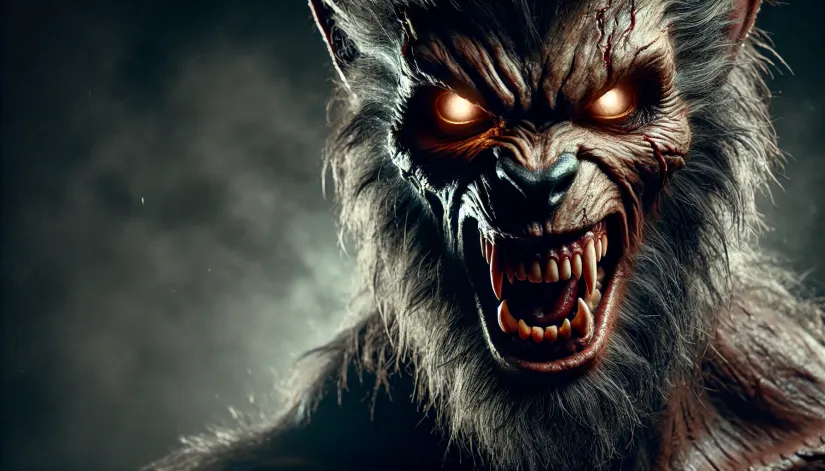
Werewolf Characteristics and Traits
Werewolves are known for their incredible strength and speed, far surpassing that of both wolves and humans. They combine traits from both species, making them one of the most intriguing mythical creatures out there.
While many think of werewolves as part of European folklore, the legend has spread across the globe.
For example, shapeshifters similar to werewolves appear in stories from various cultures worldwide.
In Native American folklore, there’s the “Skinwalker,” a person who can transform into any animal they desire.
In Japan, the “Kitsune” are foxes that can shapeshift into human form.
The “Nagual” in Mexican and Central American folklore are humans who can transform into animals, often to protect their community.
In African mythology, the “Werehyena” is a creature that can switch between human and hyena forms.
And while many of these creatures share some similarities, their characteristics and traits vary greatly. It would be virtually impossible to fit everything into just one article.
So, let’s instead focus on the werewolf (as it is described in most European stories and legends).
Appearance and Identification
In European folklore, werewolves had distinct features even in their human form. People believed they had eyebrows that met at the bridge of the nose, low-set ears, curved fingernails, and a unique swaying stride.
In their animal form, werewolves’ aspects varied from culture to culture.
They often looked like regular wolves but were usually larger and missing a tail. (Fun fact about werewolves: some folks believed the missing tail linked them to witches in animal form.)
They also kept their human eyes and (sometimes) even their voice.
To identify a werewolf in human form, some believed you could cut their flesh to reveal fur hidden within. In fact, this was a common practice during werewolf trials in the 1500s and 1600s.
For instance, during the werewolf trials in Estonia and Livonia (modern-day Latvia and Estonia), suspected werewolves were subjected to this gruesome test.
Similarly, in France, during the infamous werewolf hunts (such as the trial of the Werewolf of Bedburg in 1589), authorities often used this method to “prove” someone’s guilt.
After changing back to their human form, werewolves often felt weak, exhausted, and suffered from severe depression.
In medieval Europe, one of the most feared traits of werewolves was their aggressive and predatory behavior—which included attacking humans and livestock—and their disgusting habit of sometimes digging up and eating recently buried corpses.
But these stories are far less common. Such gruesome behaviors are more frequently associated with ghouls or revenants.
What are the Personality Traits of a Werewolf?
Werewolves often grapple with a mix of human morality and animal instincts. It’s a powerful internal struggle that can make them aggressive, unpredictable, and prone to isolation.
However, some stories depict werewolves who retain their human consciousness and show loyalty, protectiveness, and a strong sense of justice.
One such story is the legend of the “Bisclavret,” a 12th-century Breton lai by Marie de France.
In this beautiful tale, a nobleman named Bisclavret transforms into a werewolf.
He retains his human mind and noble character despite being trapped in a lupine form. Due to his loyalty and protective nature, he ultimately gained the king’s trust.
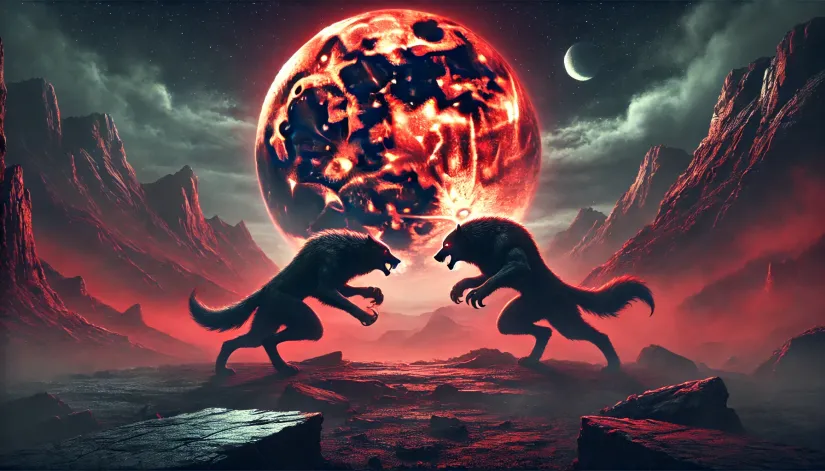
What is the Typical Behavior of a Werewolf?
Werewolf behavior can vary a lot across different stories and legends. When they transform, they often turn super aggressive, typically driven by primal urges to hunt and kill.
This savage nature makes them feared and dangerous—especially during a full moon when transformations are believed to be most common.
In human form, these beasts might have heightened senses and a strong connection to nature.
They can be more in tune with their surroundings, with sharper sight, smell, and hearing—which often makes them great hunters and trackers (even without turning into their wolf form).
Some folklore suggests that werewolves can also be cunning and strategic, using their abilities to their advantage.
In some stories, werewolves keep their human intelligence and can plan their moves carefully. This makes them formidable opponents who are not only physically strong but also mentally sharp.
However, modern interpretations emphasize a structured hierarchy within wolf packs.
While inconsistent with most older myths and stories, the modern “interpretation” of werewolf behavior and social structure has become the new norm in films and literature.
According to modern interpretations, a wolf pack is typically organized with a dominant breeding pair (known as the alphas) who lead the pack.
The alphas are responsible for maintaining order and cohesion within the group. The pack structure includes betas, mid-ranking wolves, and omegas.
Each member has a specific role, and the hierarchy helps maintain stability and social bonds within the pack.
Dominance is often expressed through tail posture, body language, and direct eye contact).
How are Werewolves Created?
Werewolves’ origins can vary widely across different folklore traditions, each offering unique transformation methods:
Bites and Scratches
One of the most common ways to become a werewolf is through the bite or scratch of another.
This method is widely popularized in modern literature and movies but has roots in older folklore, where the transfer of lycanthropy through wounds was a common theme.
According to most myths and legends, all werewolves were once human until they were scratched or bitten by a transformed or transforming werewolf, infecting them with the werewolf curse.
Curses and Witchcraft
In many tales, individuals are transformed into werewolves due to a curse. Witches or other supernatural entities often place these curses as punishment.
For example, the Greek myth of Lycaon tells of a king who was turned into a wolf by Zeus as punishment for his misdeeds.
In some stories, curses could be tied to specific times or conditions, like a full moon, increasing the mystique around these transformations.
Magical Objects and Potions
Some legends mention the use of magical items, such as enchanted belts or wolf pelts, that grant the wearer the ability to transform into a wolf. These items could be worn or used in specific rituals to induce the transformation.
In medieval European folklore, it was believed that applying a special ointment could turn a person into a wolf-like monster.
Additionally, a mixture of rare herbs known as Sitsuie and Hirsasu can transform an individual into a werewolf if injected, creating artificial werewolves with enhanced strength and savage fury.
Drinking from Wolf Tracks
It’s a less common method, but certain folklore traditions suggest that drinking water from a wolf’s paw print or consuming a potion made from specific herbs could trigger the transformation.
This belief highlights the connection between humans and wolves in the natural world, emphasizing the mystical aspects of werewolf creation.
Hereditary Lycanthropy
In some stories, the ability to transform into a werewolf is inherited.
Families believed to be cursed or blessed with lycanthropy would pass the trait down through generations.
This form of werewolfism is often depicted as more controlled, with individuals able to transform at will rather than being bound to the full moon.
Interestingly, humans are particularly vulnerable to lycanthropy during their teenage years, with half of all werewolves falling between the ages of 11 and 17.
Some speculate that this susceptibility may be due to sudden hormonal changes during puberty or a long-dormant, reawakening bloodline.
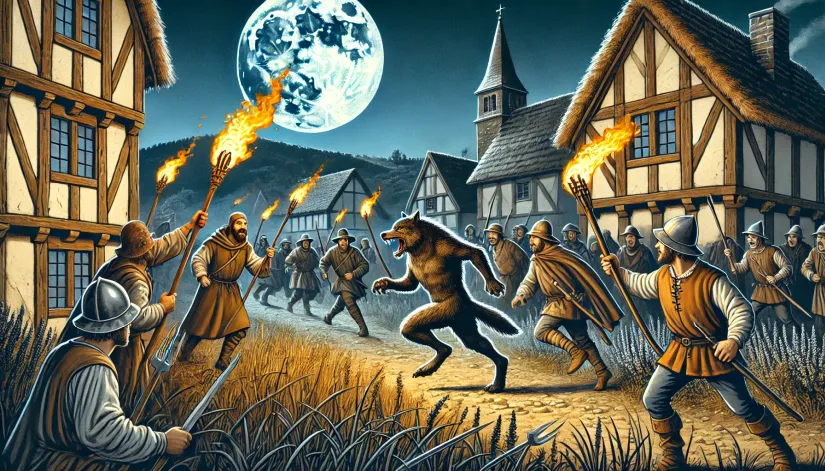
Werewolf Legends Across Cultures
Germanic Legends
In Germanic folklore, werewolves are often seen as ferocious creatures that wreak havoc on villages and livestock.
One well-known example is the story of Peter Stumpp, a 16th-century German farmer accused of being a werewolf. Stumpp was charged with committing gruesome murders in his wolf form.
Another example is the tale of the Livonian werewolf, Thiess of Kaltenbrun.
Thiess claimed he and other werewolves descended into Hell to fight witches and demons, portraying a complex view of werewolves as protectors against greater evils.
French Werewolf Trials
In 16th and 17th-century France, there were a bunch of werewolf trials ( very similar to witch trials) where people were accused of turning into wolves.
The accused were believed to do horrible things, like attacking children and desecrating graves.
Gilles Garnier—the werewolf of Dole—was a notorious example. He was eventually accused and executed for his supposed crimes.
Another notable case is that of Jean Grenier, a teenage boy who claimed to transform into a wolf and attack young girls.
Nordic Myths
In Nordic mythology, the idea of the werewolf (or “vargulf”) mixes both savagery and honor.
For instance, the “Saga of the Volsungs” includes the story of Sigmund and Sinfjotli, who wear wolf skins and become werewolves.
When transformed, they can gain a wolf’s strength and ferocity, but also keep their human minds and family loyalty.
Additionally, the legend of Ulfhednar, warrior-shamans who wore wolf pelts and were believed to channel the spirit and strength of wolves in battle, shows the reverence and fear the Nordic cultures had for these creatures.
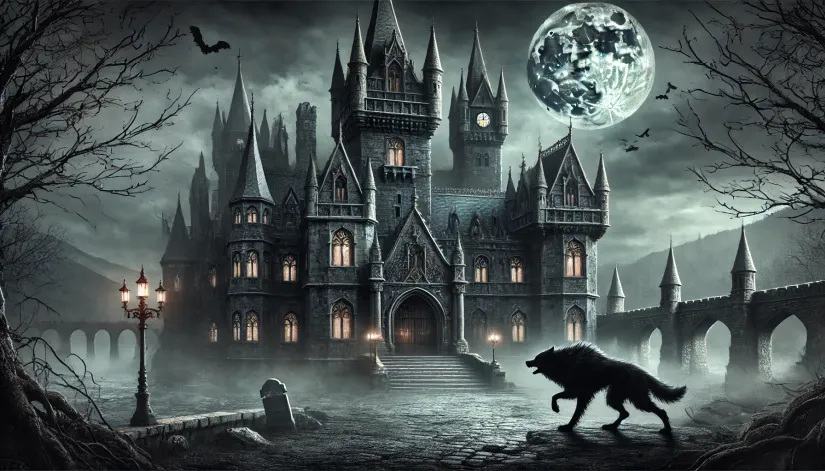
British Folklore
In British folklore, werewolves are sometimes shown with a tragic side, highlighting the inner struggle between their human and wolf natures.
The story of the “Wulver,” a kind-hearted werewolf from the Shetland Islands, is a unique example. The Wulver is depicted as a solitary creature who helps humans by fishing for them during times of famine.
Another poignant tale is that of the “Old Stinker,” a werewolf from the Yorkshire Wolds.
This creature was believed to have haunted the area for centuries, and though feared, there are accounts of it showing moments of mercy and humanity (such as sparing certain villagers from its wrath).
Greek and Roman Myths
Greek and Roman myths also feature werewolf legends, often tying them to themes of punishment and transformation.
The story of King Lycaon, who was transformed into a wolf by Zeus as punishment for his impiety and cannibalism, is one of the earliest and most influential werewolf myths.
In Roman mythology, the Lupercalia festival included rituals believed to protect people from wolves.

How Can Werewolves Be Defeated?
Werewolves are usually tough to kill with ordinary weapons. However, certain items and methods are believed to be effective.
Silver, especially silver bullets, is a well-known weakness. Other methods include using wolfsbane (a toxic plant), performing exorcisms, or using religious artifacts.
Over time, various techniques have been developed to eradicate the werewolf form.
In ancient times, the Greeks and Romans believed that exhausting a person could cure lycanthropy, making the victim undergo extensive physical activity in hopes of purging the affliction.
This approach came from the observation that many supposed werewolves felt weak and debilitated after their rampages.
During medieval Europe, there were three traditional methods for curing werewolfism: medicinal (often using wolfsbane), surgical, or exorcism.
However, many of the remedies promoted by medieval medical practitioners ended up being fatal.
In Sicily, an Arabic-influenced belief suggests that a werewolf can be cured by striking it three times on the forehead or scalp with a blade.
Another belief from the same area involves piercing the werewolf’s hands with nails. Less severe methods were sometimes also thought to work.
In the German lowlands of Schleswig-Holstein, a werewolf could be cured simply by addressing it three times by its Christian name.
In Denmark, one belief holds that just scolding a werewolf can cure it. Conversion to Christianity was also a common method for removing werewolfism during the medieval period.
Devotion to St. Hubert has been cited as both a cure for and protection against lycanthropy.
Rolling in dew is another approach believed to cure the ailment.
Do ‘Real’ Werewolves Exist?
In modern times, werewolves are often linked to psychological conditions.
Clinical lycanthropy is a rare psychiatric syndrome where a person believes they can transform into a wolf or other animal. This condition is classified under delusional disorders and can be treated with therapy and medication.
However, it wasn’t always like that. For centuries, people have believed in the existence of werewolves. But, again, certain medical conditions might have contributed to the werewolf legend:
- Hypertrichosis: Also known as “werewolf syndrome,” this rare genetic condition causes excessive hair growth all over the body.
- Rabies: This viral disease can cause symptoms like aggression, foaming at the mouth, and sensitivity to water, which could resemble the behavior of a rabid animal.
- Porphyria: This group of disorders affects the skin and nervous system, and some symptoms, like sensitivity to sunlight, might have fueled vampire and werewolf myths.
While obviously, neither of these rare conditions can turn someone into a werewolf, such conditions could easily be mistaken for evidence of werewolfism.

